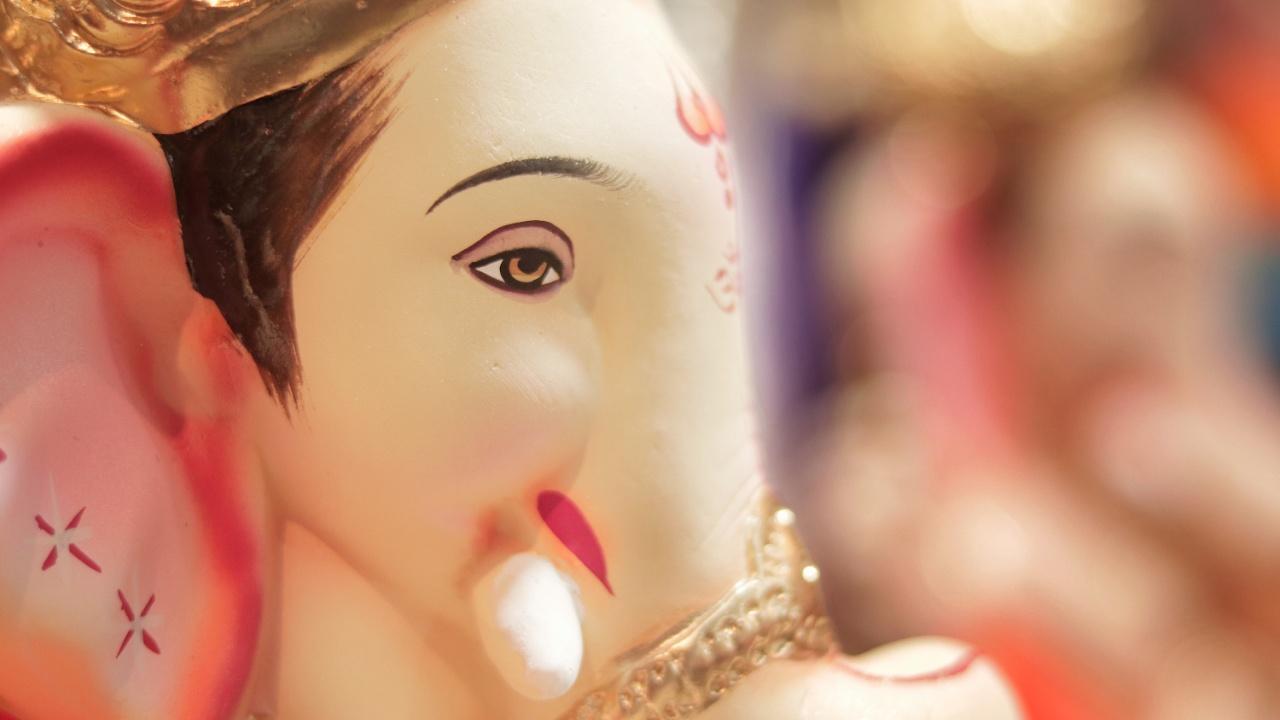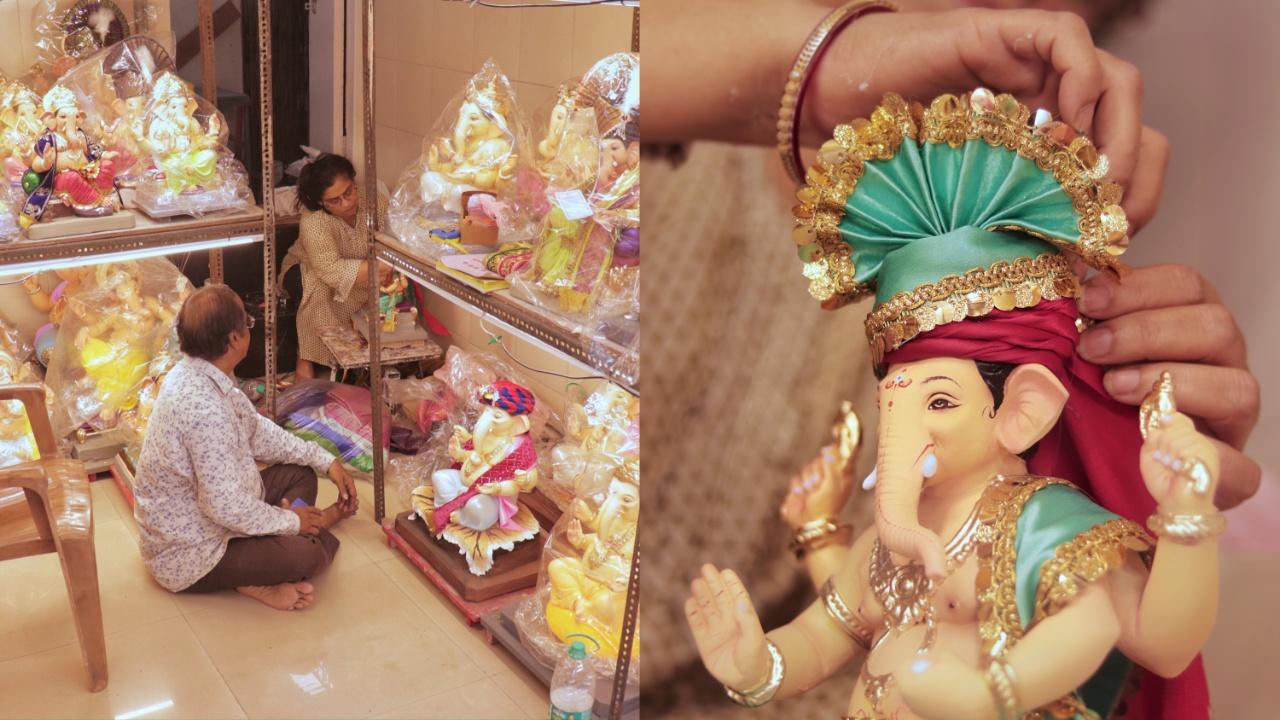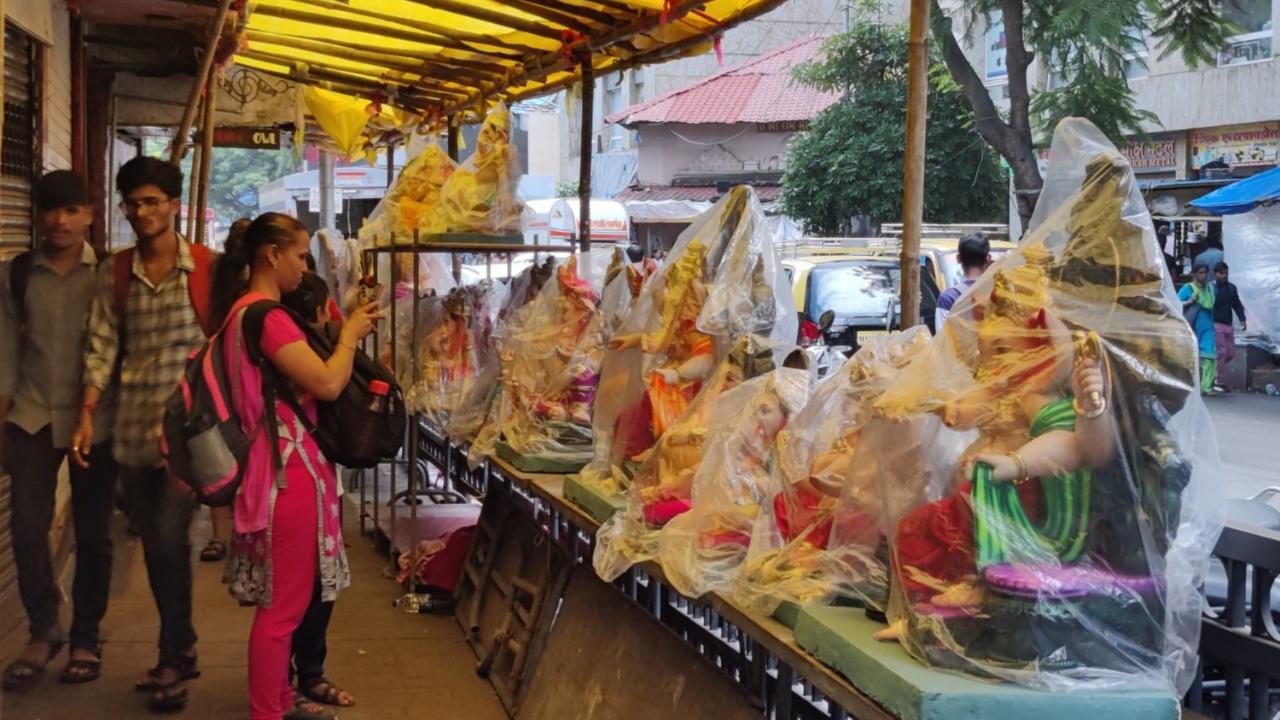Ahead of Ganesh Chaturthi 2023, we spoke to idol makers of Dadar who highlight the struggles of meeting customer demands, the need to preserve culture and the art of idol-making

Every year, murtikars make a sale of over 350 idols. These idol makers sell murtis at prices starting from Rs 2,000 which go up to Rs 16,000 depending on the size and its artistic value. Photo Courtesy: Amogh Golatkar
Key Highlights
- Murtikars who have been making idols for the past 30 years feel dejected
- Buyers choose to buy murtis made from plaster of paris over their beautiful pieces of art
- This is because they are available at throwaway prices
The beautiful murtis (idols) of Lord Ganesha that we bring into our homes and adorn with much love are all efforts of the talented murtikars. Sadly though, their attention to detail and intricate artistic skills often goes unnoticed by most buyers. Murtikars, especially, those who have been making idols for the past 30 years feel dejected when buyers choose to buy murtis made from plaster of paris (POP) over their beautiful pieces of art only because they are available at throwaway prices. Ahead of Ganesh Chaturthi 2023, Mid-Day conversed with murtikars based in Dadar, a popular destination in Mumbai for all festival shopping, who share details about customer preferences and the art of idol making.
ADVERTISEMENT
Also Read: Why grander Ganpati idols are taking the centre stage during festivity
Yatin Kishor Divekar, a 40-year-old murtikar who developed an interest in making murtis at the age of 15 is now the owner of Omkar Ganesh Pratimalay, a Ganpati stall selling idols made of POP and clay. Speaking about the customer base, he says, “Even though Dadar is a prime location for people to shop from during festivals, it does not benefit us much. We hardly manage to attract new customers.”
The stall has been selling Ganesha idols for the last 30 years and was founded by Divekar’s father, Kishore Govind Divekar (65) who is a self-learned murtikar himself. 
Idols on sale at Omkar Ganesh Pratimalay, Dadar. Photo Courtesy: Amogh Golatkar
Although the father-son duo laments not being able to pull in new customers, they are proud of having preserved the Maharashtrian culture of making idols the traditional way and retaining their old customers.
They enjoy the loyalty of their customers who are spread across Mumbai. The duo also has customers based in Dubai and the USA who book idols from them every year.
Reimaging Lord Ganesha's idols
Each year, we witness different variations of Lord Ganesha. Last year, the market saw Ganesha idols inspired by South Indian actor Allu Arjun’s Pushpa character. On being asked about his thoughts on the same and whether they sell such idols, Yatin, laughs and says, “I don’t like this concept. I personally feel gods should be viewed and worshipped in their original form.” Yatin prefers sticking to the traditional way of making idols but agrees that slight variations in their ‘asan’ and ‘vahan’ are still fine.
Commenting on the same, another Dadar-based idol seller Santosh Nirvan (53) of Atharva Arts who sells only eco-friendly idols, says, “We don’t make such idols. We only make traditional murtis that fall within the confines of year’s long cultural construct.”

Santosh Nirvan of Atharva Arts, Dadar. Photo Courtesy: Amogh Golatkar
Nirvan sells Ganesha idols made by his son-in-law Mahesh Trimbak Kadam (30) who has over 27 years of experience. Speaking about the culture residents of Dadar hold so dear, Nirvan says, “Maharashtrians in Dadar are very sensitive about preserving their culture. They consider filmy or animated variations in Ganesha idols a mockery and a disrespect towards God.” Sharing an interesting piece of information, Nirvan says that those families who have been bringing Bappa home for decades hardly make any changes in his appearance as they treat him as their own family member. However, this number is small as compared to buyers looking to buy idols at affordable prices.
The ills of mass-produced idols
Every year, around 15 days prior to the day of Ganesh Chaturthi, the lanes and even main roads in Dadar and other areas of Mumbai get occupied by PoP (Plaster of Paris) idol sellers who sell murtis made in factories located outside the city mainly in Pen, Raigad district of Maharashtra. The idols brought from Pen are then painted here.

Idols kept on sale on one of the main roads of Dadar. Photo Courtesy: Aakanksha Ahire
Giving strong competition to murtikars, these sellers sell shiny and attractive idols at shocking rates of just Rs 500 per piece. For most customers, this seems like a great deal and feel no need to pay heed to the artistic value of idols.
Throwing light on this, Nirvan adds, “Making idols with PoP gives artists more creative freedom. It enables them to shape the idols as they wish, which is not possible with clay.”
In a disturbing revelation, Nirvan also points out that once these sellers are done selling and making a profit, they leave behind the unsold idols in order to save the cost of carrying them back, only for the BMC to clean up the mess later. “It's heart-wrenching to see Ganesha idols left in the middle of the footpaths and roads,” says a disappointed Nirvan.
Art of making Ganesha idols
Most murtikars in Dadar mostly make idols from clay commonly known as ‘shadu mati’ which is eco-friendly in nature. The process of making idols from clay, right from beating to maintaining the quality of the idol till the time it is sold, is tedious.
For Yatin, the most difficult part of idol-making is beating the clay. Any mistake in it can hamper the whole process of perfecting the idols. The complete making of one idol takes over six days depending on the size.
After the idol is shaped, its clay takes about four days to dry completely. Further, painting the entire idol and detailing its facial features takes an additional three days. Painting of clay idols takes time as they absorb the colours and require repeated brush strokes unlike POP idols that hold the colour in place for a long time.
Once the idols are ready to be sold, they are all placed under LED bulbs. The strong heat radiated from these bulbs helps the clay idols to stay dry, protecting them from catching moisture.
Every year, murtikars make a sale of over 350 idols. These idol makers sell murtis at prices starting from Rs 2,000 which go up to Rs 16,000 depending on the size and its artistic value.
To cater to all the orders with complete precision, murtikars start prepping and making a fresh batch of idols six to eight months prior to the festival.
 Subscribe today by clicking the link and stay updated with the latest news!" Click here!
Subscribe today by clicking the link and stay updated with the latest news!" Click here!












